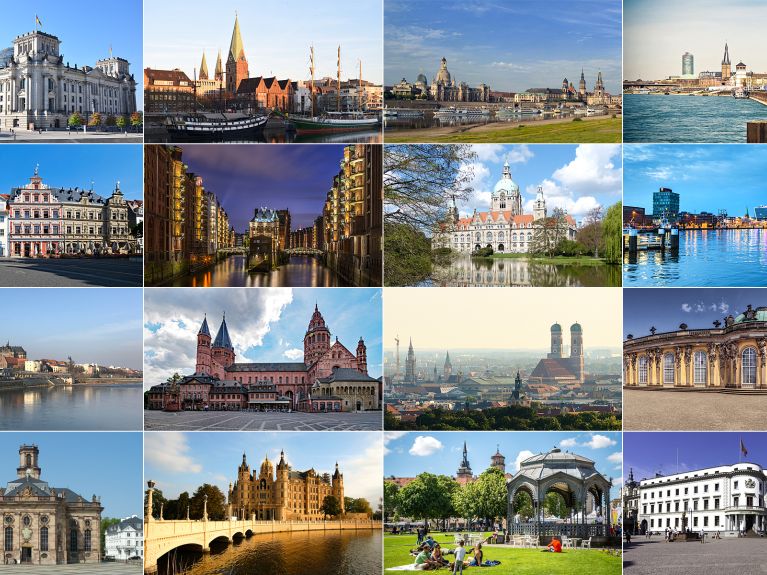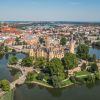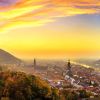State Capitals of Germany
How many federal states and state capitals does Germany have? This list provides an overview of the state capitals and their special features.

Berlin
Creative, fast-paced, open-minded: Since the fall of the Wall, Berlin has become one of the most exciting, liveliest cities in Europe. The 3.9-million metropolis, which is the capital city of the country as well as of a German state, moves fast. Berlin is the venue of in excess of one thousand events a day, including the state opera, openings of new art exhibitions in inner courtyards or multicultural festivals.
Bremen
"Bremen in three minutes." Is that possible? It is – on an official tour with the "City Informants of Bremen". Learn about the history of the tiny state, which has consisted of two cities since 1947. Bremerhaven's own website has been integrated into Bremen's.
Dresden
If you are looking for an apartment in Dresden, take a look at the list of rents which you can download from the official website www.dresden.de. Then you can easily find the right registration office here.
Düsseldorf
Düsseldorf’s historic town center is renowned as the “longest bar in the world”. More than 250 breweries, pubs, bars and restaurants are lined up one beside the other in the narrow alleyways in the downtown area. The state capital of North Rhine-Westphalia is also world-famous for the “Königsallee” (King’s Avenue) with its glittering luxury boutiques. Advertising, fashion and telecommunications – all these branches have their roots in the tradeshow center of Düsseldorf.
Erfurt
A picture book of German history: Erfurt, the state capital of Thuringia, is situated in the heart of Germany. The Luther, Minster and flower city has one of the most well-preserved medieval city centers in Germany. Two large churches, the Mariendom and the Severikirche, which stand side by side, have become the city’s trademark. Many streams and rivers, bridges and towers, half-timbered houses and Renaissance buildings characterize the historical cityscape.
Hamburg
A metropolis of millions steeped in history on the Elbe River: the Free and Hanseatic City of Hamburg is a German state, the country’s second largest city and the most important center for foreign trade in Germany all rolled into one. Huge container ships sail daily through the “door to the world”, Hamburg’s overseas port. Every third container comes from China or is being shipped there.
Hannover
The people in the capital city of Lower Saxony love Hannover because it’s so “green”. Whether it’s in the famous Baroque “Herrenhäuser Gardens” or Europe’s largest city forest, the “Eilenriede” – the international tradeshow center offers plenty of spaces for rest and recreation. Sailing enthusiasts can even hoist their anchors on Masch Lake!
www.hannover.de
Kiel
As the gate to Scandinavia, the northernmost state capital in Germany has been an important junction between north and south for more than fiftyfive years – and now toward the east as well. Water is the most important element for the tradition-rich shipyards and maritime city. Cruise ships and Baltic Sea ferries set sail into the sea from the Kiel harbor.
Magdeburg
Between traditions of the past and the future: The Elbe River flows directly through the state capital of Saxony-Anhalt along the “Magdeburger Börde”, a fertile lowland area. Magdeburg’s port is one of Germany’s largest inland ports. While East Germany still existed, the former imperial city was known as the “city of heavy engineering” – nowadays, Magdeburg places a stronger focus on research and innovation in its two universities and academic institutes.
Mainz
Gutenberg’s birthplace, media metropolis and major Carnival center: The capital city of Rhineland-Palatinate and university city of Mainz is situated in the heart of Germany’s largest winegrowing region on the Rhine River. This is where Johannes Gutenberg invented movable type printing in Europe in the 15th century.
Munich
At the “Wiesn“, the Munich Oktoberfest – the largest public festival worldwide – around 7 million liters of beer are drunk each year. That may be impressive, but be sure you also pay a visit to the extensive official Munich Portal to find out what else is going on in the extraordinary capital city of Bavaria.
Potsdam
Potsdam is not just Sanssouci. Here architects such as Schinkel, von Knobelsdorff and Lenné created a diverse urban landscape. In 1990 the palaces, gardens and parks were designated world cultural heritage. Like an island surrounded by the Havel lakes, Potsdam also offers many sports and leisure options.
www.potsdam.de
Saarbrücken
“Salü!” is how the inhabitants of Saarbrücken traditionally greet one another; after all, they live close to the border to France and this region has actually belonged to France now and again in the past. Saarbrücken has been the capital city of and the only major city in Saarland since 1957. In 1909, the baroque town of Saarbrücken merged with the market town of St. Johann and the industrial town of Malstatt/Burbach to create the city of Saarbrücken as it is today.
Schwerin
Water-lovers won’t have far to go in Schwerin – one quarter of the city’s area is made up of picturesque lakes. A trademark of the state capital of Mecklenburg-Western Pomerania is the “Fairytale Castle” with its magnificent rooms and orange groves. Major local industries include medical and hydrogen technology and mechanical engineering.
Stuttgart
The automotive industry, wine growing and “späetzle”, a local specialty – that’s what Stuttgart is most famous for. The state capital of Baden-Württemberg, which is home to close to 600,000 people, is the center of one of the most industrialized regions in the Federal Republic. And on the cultural scene, Stuttgart is no longer just an insider tip: the state theater, art museums or the “Weissenhofsiedlung”, an impressive complex of buildings, have transformed the city in the southwest of Germany into an attractive destination for people from all over the world.
Wiesbaden
The state capital of Hesse, Wiesbaden, is situated in a valley between the Taunus and the Rhine Rivers, one of the most picturesquely located and warmest cities in Germany. Extensive parks and magnificent buildings characterize the classical flair of the city that was once a “world spa”. The ancient Romans had already discovered the delights of its thermal springs.

